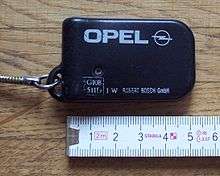Immobiliser
An immobiliser or immobilizer is an electronic security device fitted to a motor vehicle that prevents the engine from running unless the correct key (transponder or smart key) is present. This prevents the vehicle from being "hot wired" after entry has been achieved and thus reduces motor vehicle theft. Research shows that the uniform application of immobilisers reduced the rate of car theft by 40%.[1]


Description
The electric immobiliser/alarm system was invented by St. George Evans and Edward Birkenbuel and patented in 1919.[2] They developed a 3x3 grid of double-contact switches on a panel mounted inside the car so when the ignition switch was activated, current from the battery (or magneto) went to the spark plugs allowing the engine to start, or immobilizing the vehicle and sounding its horn.[3] The system settings could be changed each time the car was driven.[3] Modern immobiliser systems are automatic, meaning the owner does not have to remember to activate it.[4]
Immobilisers have been mandatory in all new cars sold in Germany since 1 January 1998, in the United Kingdom since 1 October 1998, in Finland since 1998, in Australia since 2001 and in Canada since 2007. Early models used a static code in the ignition key (or key fob) which was recognised by an RFID loop around the lock barrel and checked against the vehicle's engine control unit (ECU) for a match. If the code is unrecognised, the ECU will not allow fuel to flow and ignition to take place. Later models use rolling codes or advanced cryptography to defeat copying of the code from the key or ECU.
The microcircuit inside the key is activated by a small electromagnetic field which induces current to flow inside the key body, which in turn broadcasts a unique binary code which is read by the automobile's ECU. When the ECU determines that the coded key is both current and valid, the ECU activates the fuel-injection sequence.
In some vehicles, attempts to use an unauthorised or "non-sequenced" key cause the vehicle to activate a timed no-start condition and in some highly advanced systems, even use satellite or mobile phone communication to alert a security firm that an unauthorised attempt was made to code a key.
Coincidentally, this information is often recorded in modern automobile ECUs, which may record many other variables including speed, temperature, driver weight, geographic location, throttle position and yaw angle. This information can be used during insurance investigations, warranty claims or technical troubleshooting.
Availability
Add-on immobilisers are available for older cars or vehicles that do not come equipped with factory immobilisers. The insurance approval for a self-arming immobiliser is known as "Thatcham 2" after the Motor Insurance Repair Research Centre in Thatcham, England. Approved immobilisers must intercept at least two circuits; typically the low-voltage ignition circuit and the fuel pump circuit. Some may also intercept the low-current starter motor circuit from the key switch to the relay.
Statistics in Australia show that three out of four vehicle thefts are older cars stolen for joyriding, transport, or to commit another crime. Immobilisers are fitted to around 45% of all cars in Australia, but account for only 7% of those cars that are stolen. In many instances where a vehicle fitted with an immobiliser has been stolen, the thief had access to the original key. Only around one in four stolen vehicles are stolen by professional thieves. The majority of vehicles are stolen by opportunistic thieves relying on finding older vehicles that have ineffective security or none at all.
Honda was the first motorcycle manufacturer to include immobilisers on its products in the 1990s.[5]
In September 2007, a Transport Canada regulation mandated the installation of engine immobilisers in all new lightweight vehicles and trucks manufactured in Canada.[6]
Cracking
Numerous vulnerabilities have been found in the immobilisers designed to protect modern cars from theft.[7] Many vehicle immobilisers use the Megamos-chip, which has been proven to be crackable.[8] The Megamos transponder is one of many different transponders found in today's immobiliser systems and also comes in many different versions. Hacking of an immobiliser in the real world would be performed on the vehicle, not on the key. It would be faster to program a new key to the vehicle than to try to clone the existing key, especially on modern vehicles.
Some immobiliser systems tend to remember the last key code for so long that they may even accept a non-transponder key even after the original key has been removed from the ignition for a few minutes.[9]
Effectiveness
A 2016 study in the Economic Journal finds that the immobiliser lowered the overall rate of car theft by about 40% between 1995 and 2008.[1] The benefits in terms of prevented thefts are at least three times higher than the costs of installing the device.[1]
See also
References
- van Ours, Jan C.; Vollaard, Ben (1 June 2016). "The Engine Immobiliser: A Non-starter for Car Thieves". The Economic Journal. 126 (593): 1264–1291. doi:10.1111/ecoj.12196. ISSN 1468-0297.
- "Automobile-theft preventer". 8 April 1919. Retrieved 24 February 2015.
- Torchinsky, Jason (11 April 2013). "The First Car Alarm Was Sort Of Like A Puzzle". Jalopnik. Retrieved 24 February 2015.
- "What is an immobilizer?". wisegeek.com/. Retrieved 24 February 2015.
- "Tech-Spot: Honda's HISS" (Press release). Honda News. 3 August 2007. Retrieved 24 February 2015.
- "Anti-theft device now mandatory in Canadian-made vehicles". CBC News. Canadian Broadcasting Corporation. 1 September 2007. Retrieved 5 November 2016.
- Graham-Rowe, Duncan (6 December 2010). "Criminals find the key to car immobilizers". New Scientist (2789). Retrieved 24 February 2015.
- Verdult, Roel; Garcia, Flavio D.; Ege, Barış (2013). "Dismantling Megamos Crypto: Wirelessly Lockpicking a Vehicle Immobilizer" (PDF). 22nd USENIX Security Symposium. Retrieved 24 February 2015.
- Volkswagen Immobiliser Failure
External links
| Look up immobiliser in Wiktionary, the free dictionary. |
- Motor Insurance Repair Research Centre in Thatcham
- Theft Deterrent Program at the Insurance Bureau of Canada
- Instructions on how to replace a car key